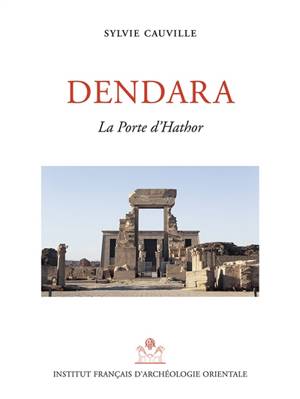
- Retrait gratuit dans votre magasin Club
- 7.000.000 titres dans notre catalogue
- Payer en toute sécurité
- Toujours un magasin près de chez vous
- Retrait gratuit dans votre magasin Club
- 7.000.000 titres dans notre catalogue
- Payer en toute sécurité
- Toujours un magasin près de chez vous
Description
À Dendara, trois portes monumentales donnent accès respectivement aux domaines d'Hathor, d'Horus d'Edfou et d'Isis. Diverses cérémonies se déroulaient à proximité de ces édifices où la population profane pouvait s'approcher au plus près de l'enceinte sacrée.
La Porte d'Hathor ouvrant sur le domaine de la déesse constitue l'ultime témoignage architectural d'un site dont les archives remontent au temps de Khéops. Elle fut édifiée sous les règnes de Domitien et de Trajan (81-117 apr. J.-C.). Images et mots décrivent les rites, accompagnés de réjouissances sur l'esplanade (rwt-dỉ-mȝʽt), marquant le passage d'une année à l'autre. Hathor et Isis, mères qui allaitent leur enfant, sont également et surtout de belles femmes veillant sur l'institution royale et recevant des offrandes spécifiques (rituel d'apaisement par la musique des sistres, présentation du bandeau d'électrum et du mammisi).
On trouvera dans le présent ouvrage l'édition des inscriptions hiéroglyphiques et la couverture photographique complète du monument.
At Dendara, three monumental gates gave access to the respective domains of Hathor, Horus of Edfu, and Isis. Various ceremonies were held near these structures, where the public could approach the sacred precinct as closely as possible.
The Hathor Gate, opening into the domain of the goddess, was the final architectural testimony at a site whose archives dated back to the time of Khufu. It was built during the reigns of Domitian and Trajan (81-117 AD). Images and words describe the rites marking the passage from one year to the next, accompanied by public celebrations on the esplanade (rwt-dỉ-mȝʽt). Hathor and Isis, mothers who breastfeed their children, are also and above all beautiful women watching over the institution of royalty and receiving specific offerings (ritual of appeasement by music of the sistra, and presentation of an electrum band and the mammisi).
This publication contains the edition of the hieroglyphic inscriptions and complete photographic coverage of the monument.
Spécifications
Parties prenantes
- Auteur(s) :
- Editeur:
Contenu
- Nombre de pages :
- 120
- Langue:
- Français
- Collection :
Caractéristiques
- EAN:
- 9782724707762
- Date de parution :
- 17-06-21
- Format:
- Livre relié
- Format numérique:
- Genaaid
- Dimensions :
- 250 mm x 330 mm
- Poids :
- 812 g







